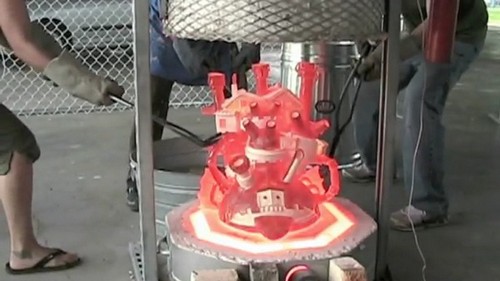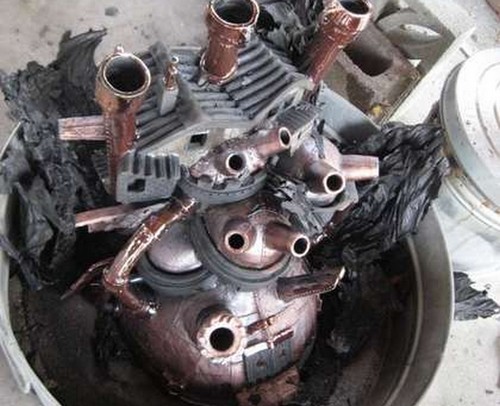A gigantic, steampunk castle that has sprouted legs and travels war-rifed land like it’s nobody’s business makes good material for a sculpture. Liz Zomarek’s ceramic rendition not only stands out for staying as true to the original as the medium allows, but also because it survived with honors the taxing firing process known as Raku.
In order for clay to turn into ceramic, it needs to be baked in a kiln. There are several ways to go about this and Raku, developed in 16th century Japan, is one of them.
If you bake your pots Raku-style, it means you must remove them from the kiln using tongs when a whooping maximum temperature of 1800 °F (982 °C, approximately) is reached. Pots are subsequently submitted to a “reduction” process inside a container with sand or sawdust. In other words, they are made to cool rapidly and the sharp thermal contrast leaves characteristic fine cracks all over their surface. Sometimes they even break all the way. Olden Japanese potters didn’t see this as a bad thing; they simply welded the pieces back together and the resulting pot was considered more valuable still due to its visible “scarring”. This wasn’t a welcome prospect by Liz, who spent unbelievable amounts of time in the making of her castle.
Owner of the Artisan Cake Company in Oregon, Portland, Liz is used to crafting three-dimensional edible sculptures with minute detail, but her Howl project was on quite a different level. She had to carve and mold most parts separately so that the whole thing remained stable and didn’t topple over due to heavy weight. At the end of each day of work she wrapped what she’d made in plastic to aid in the drying process. Even so, the entire thing took a total of 6 months to dry successfully. She also had to add handles to the sides and the back of the castle in order for the tongs to be able to fish it out of the kiln. These handles appear quite unobtrusive and blend in nicely with the design.
Prior to “raku’ing” her creation, Liz placed it in a bisque kiln to prevent it from cracking or even exploding later. Bisque firing is not as brusque a technique as Raku and it strengthens the pottery, leaving it nevertheless porous enough for it to absorb the glazes that Liz applied afterwards.
Finally, it was Raku time. The main danger was that the castle is much bigger and more intricate than the ware that usually goes through Raku and there wasn’t a big chance of it coming out unscathed, despite all the precautions that’d been taken. Miraculously though, the only damage it sustained was a broken wing which could be re-attached without difficulty. The firing accentuated the coppery, oily, slick tones of the glazes and made for a very appealing end product.
In the video you can see how the scalding hot fortress is picked up by three people, placed in a bucket with sand and newspaper, covered with a can to make it cool off and uncovered at last to reveal a thing of beauty. Perhaps Howl’s resident fire demon, Calcifer, had something to do with it turning out so well against all odds.
Other geeky ceramic goodies previously featured on Walyou include Ceramic Speakers for Aesthetic Musical Experience and The Circuit Board Ceramic Speaker. For another interesting rendition of Howl’s castle, read Howl’s Moving Castle Papercraft Is Made To Perfection!
Via: Craftzine












